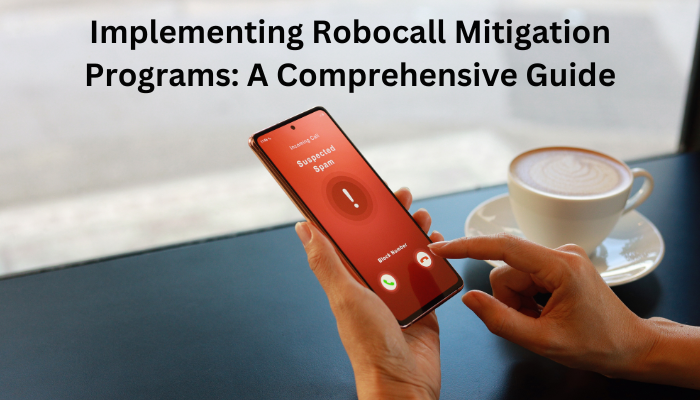
Implementing Robocall Mitigation Programs: A Comprehensive Guide
October 25, 2024 Comment off
Robocalls have become a significant issue in telecommunications, with billions of unwanted calls disrupting consumers and businesses every year. To combat this problem, the Federal Communications Commission (FCC) has mandated that all voice service providers implement robocall mitigation programs. These programs aim to detect, analyze, and block illegal robocalls, ensuring that only legitimate calls reach end-users. For businesses and service providers, understanding how to implement these programs is crucial not just for compliance but also for maintaining customer trust and network integrity. In this article, we’ll explore the importance of robocall mitigation and outline actionable steps to deploy an effective program.
1. Understanding the FCC’s Mandate
Why Robocall Mitigation Matters
The FCC has implemented strict measures to curb the surge of illegal robocalls, requiring voice service providers to implement frameworks like STIR/SHAKEN (Secure Telephone Identity Revisited/Signature-based Handling of Asserted Information Using toKENs) and robocall mitigation plans. Non-compliance can result in severe penalties, including the risk of being blocked by other carriers. Therefore, adopting a robust robocall mitigation strategy is essential to:
- Comply with regulatory requirements: The FCC requires providers to register their robocall mitigation efforts in a database, ensuring transparency and accountability.
- Protect customers from fraud: Illegal robocalls can lead to scams, phishing attempts, and other fraudulent activities, putting customers at risk.
- Maintain network reliability: Effective mitigation reduces network congestion and improves the overall quality of service.
2. Key Components of a Robocall Mitigation Program
What Makes a Successful Program?
An effective robocall mitigation program should focus on the following elements:
- Call Authentication and Verification: Use protocols like STIR/SHAKEN to authenticate caller IDs and verify the legitimacy of incoming calls. This ensures that callers are who they claim to be, reducing the chances of spoofed calls.
- Real-Time Monitoring and Analysis: Implement systems that can analyze call patterns in real-time to detect anomalies. Suspicious activity, such as a sudden spike in call volume from a particular number, should be flagged for further investigation.
- Automated Blocking and Filtering: Deploy automated tools that can block or filter out illegal robocalls before they reach end-users. These tools should be capable of identifying known scam numbers and using machine learning to detect new threats.
3. Steps to Implementing a Robocall Mitigation Program
How to Set Up an Effective System
Here’s a step-by-step guide to implementing a robust robocall mitigation program:
Step 1: Conduct a Network Assessment
- Start by assessing your current network to identify vulnerabilities and gaps. Understand where robocalls are entering your system and how they are being routed. This will help in designing a more effective mitigation strategy.
Step 2: Deploy STIR/SHAKEN Protocols
- Implement STIR/SHAKEN technology to authenticate caller information. This involves verifying that the caller ID has not been spoofed and ensuring that calls originate from a trusted source. This is a mandatory requirement for most providers in the United States.
Step 3: Establish a Robocall Mitigation Database
- Register your robocall mitigation program with the FCC’s Robocall Mitigation Database. This is a regulatory requirement for all voice service providers, and failure to do so can result in penalties.
Step 4: Integrate Real-Time Call Analytics
- Utilize real-time analytics to monitor call patterns and detect suspicious activity. AI and machine learning can be particularly effective here, as they can learn to identify new robocall tactics based on historical data and adapt to evolving threats.
Step 5: Implement Automated Blocking and Filtering
- Set up automated systems to block or filter illegal calls. These systems should be updated regularly to recognize new scam patterns and emerging threats. Ensure that the system has minimal false positives to avoid blocking legitimate calls.
Step 6: Regularly Update and Maintain the System
- Robocall tactics are constantly evolving, so your mitigation system should be regularly updated to adapt to new threats. This includes updating software, refreshing databases of known scam numbers, and refining machine learning models.
4. Best Practices for Effective Robocall Mitigation
Tips for Ongoing Success
- Collaborate with Other Carriers: Work with other voice service providers to share information about known robocall patterns and scam numbers. Collaboration helps create a more robust defense against illegal robocalls across the network.
- Educate Your Customers: Inform your customers about how they can protect themselves from robocalls, such as by not answering calls from unknown numbers or using call-blocking apps. Transparency about your robocall mitigation efforts can also build trust.
- Monitor Compliance Regularly: Regularly review your program to ensure it aligns with FCC regulations and industry standards. Conduct audits and assessments to identify areas for improvement and maintain compliance.
5. Challenges in Implementing Robocall Mitigation
Overcoming Common Obstacles
While implementing a robocall mitigation program is essential, it does come with challenges. Here are some common obstacles and how to address them:
- Integration with Legacy Systems: Many service providers have older infrastructure that may not be compatible with new robocall mitigation technologies. Consider gradual integration or investing in system upgrades to address this issue.
- Maintaining Low False Positives: Blocking legitimate calls can frustrate customers and harm your business reputation. Ensure that your systems are finely tuned to minimize false positives while effectively filtering out illegal calls.
- Keeping Up with Evolving Threats: Robocallers are constantly finding new ways to bypass mitigation efforts. Stay updated on the latest trends and invest in adaptive technologies that can respond to new tactics.
Robocall mitigation is no longer optional—it’s a regulatory requirement and a business necessity. By implementing a robust program, voice service providers can protect their customers, comply with FCC mandates, and preserve the integrity of their networks. Following the steps and best practices outlined in this article will help you build an effective robocall mitigation strategy, ensuring that your business remains compliant and your customers remain safe.